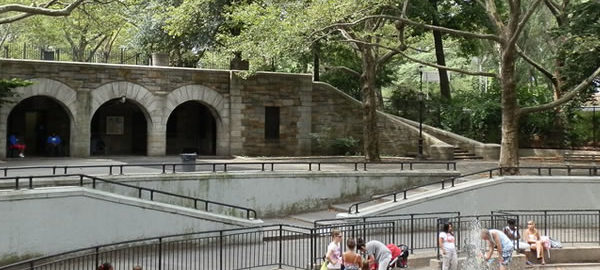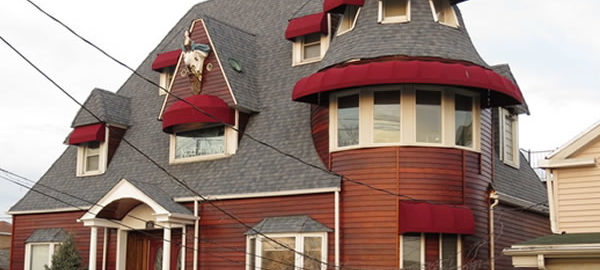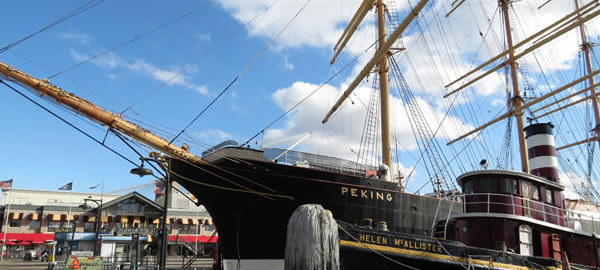Riverside Park is another creation of Frederick Law Olmsted and Calvert Vaux – the powerhouse team who also designed Central Park and Prospect Park.
Riverside Park extends from 72nd Street to 158th Street along the Hudson River. It was built in 1875-1910; Robert Moses expanded and enhanced the park during the 1930s – adding the Henry Hudson parkway and covering up the former New York Central tracks, which had cut off access to much of the park. In the 1990s, Riverside Park South was created over the former Penn Central rail yards, in a Donald Trump-led development. (This photo gallery covers Riverside park’s main section, 72nd-125th Street.)
More information is available at the Parks Department and Riverside Park Fund sites: www.nycgovparks.org and www.riversideparkfund.org/.




![TS_4386_7_8_fused [12/19/2011 11:41:59 AM] TS_4386_7_8_fused [12/19/2011 11:41:59 AM]](https://www.newyorkitecture.com/wp-content/gallery/subways/ts_4386_7_8_fused.jpg)
![CC_13291_2_3_fused [12/17/2011 10:36:36 AM] CC_13291_2_3_fused [12/17/2011 10:36:36 AM]](https://www.newyorkitecture.com/wp-content/gallery/subways/cc_13291_2_3_fused.jpg)
![IMG_3885_6_7_fused [12/19/2011 9:28:11 AM] IMG_3885_6_7_fused [12/19/2011 9:28:11 AM]](https://www.newyorkitecture.com/wp-content/gallery/subways/img_3885_6_7_fused.jpg)
![IMG_3599_600_601_tonemapped [10/21/2011 11:10:11 AM] IMG_3599_600_601_tonemapped [10/21/2011 11:10:11 AM]](https://www.newyorkitecture.com/wp-content/gallery/subways/img_3599_600_601_tonemapped.jpg)
![IMG_1854 [12/3/2011 10:56:26 AM] IMG_1854 [12/3/2011 10:56:26 AM]](https://www.newyorkitecture.com/wp-content/gallery/subways/img_1854.jpg)

![IMG_9243 [11/20/2011 12:19:09 PM] IMG_9243 [11/20/2011 12:19:09 PM]](https://www.newyorkitecture.com/wp-content/gallery/gramercy-park-vicinity/img_9243.jpg)
![IMG_9181 [11/20/2011 12:01:45 PM] IMG_9181 [11/20/2011 12:01:45 PM]](https://www.newyorkitecture.com/wp-content/gallery/gramercy-park-vicinity/img_9181.jpg)
![IMG_9186 [11/20/2011 12:03:25 PM] IMG_9186 [11/20/2011 12:03:25 PM]](https://www.newyorkitecture.com/wp-content/gallery/gramercy-park-vicinity/img_9186.jpg)
![IMG_9189 [11/20/2011 12:04:40 PM] IMG_9189 [11/20/2011 12:04:40 PM]](https://www.newyorkitecture.com/wp-content/gallery/gramercy-park-vicinity/img_9189.jpg)
![IMG_9192 [11/20/2011 12:05:36 PM] IMG_9192 [11/20/2011 12:05:36 PM]](https://www.newyorkitecture.com/wp-content/gallery/gramercy-park-vicinity/img_9192.jpg)
![IMG_9207 [11/20/2011 12:09:01 PM] IMG_9207 [11/20/2011 12:09:01 PM]](https://www.newyorkitecture.com/wp-content/gallery/gramercy-park-vicinity/img_9207.jpg)
![IMG_9211 [11/20/2011 12:09:30 PM] IMG_9211 [11/20/2011 12:09:30 PM]](https://www.newyorkitecture.com/wp-content/gallery/gramercy-park-vicinity/img_9211.jpg)
![IMG_9213 [11/20/2011 12:10:32 PM] IMG_9213 [11/20/2011 12:10:32 PM]](https://www.newyorkitecture.com/wp-content/gallery/gramercy-park-vicinity/img_9213.jpg)
![IMG_9219 [11/20/2011 12:11:40 PM] IMG_9219 [11/20/2011 12:11:40 PM]](https://www.newyorkitecture.com/wp-content/gallery/gramercy-park-vicinity/img_9219.jpg)
![IMG_9177 [11/20/2011 12:00:57 PM] IMG_9177 [11/20/2011 12:00:57 PM]](https://www.newyorkitecture.com/wp-content/gallery/gramercy-park-vicinity/img_9177.jpg)
![IMG_9246 [11/20/2011 12:19:54 PM] IMG_9246 [11/20/2011 12:19:54 PM]](https://www.newyorkitecture.com/wp-content/gallery/gramercy-park-vicinity/img_9246.jpg)
![IMG_9249 [11/20/2011 12:21:16 PM] IMG_9249 [11/20/2011 12:21:16 PM]](https://www.newyorkitecture.com/wp-content/gallery/gramercy-park-vicinity/img_9249.jpg)
![IMG_9255 [11/20/2011 12:22:15 PM] IMG_9255 [11/20/2011 12:22:15 PM]](https://www.newyorkitecture.com/wp-content/gallery/gramercy-park-vicinity/img_9255.jpg)
![IMG_9267 [11/20/2011 12:29:21 PM] IMG_9267 [11/20/2011 12:29:21 PM]](https://www.newyorkitecture.com/wp-content/gallery/gramercy-park-vicinity/img_9267.jpg)
![IMG_9273 [11/20/2011 12:30:50 PM] IMG_9273 [11/20/2011 12:30:50 PM]](https://www.newyorkitecture.com/wp-content/gallery/gramercy-park-vicinity/img_9273.jpg)
![IMG_9276 [11/20/2011 12:32:03 PM] IMG_9276 [11/20/2011 12:32:03 PM]](https://www.newyorkitecture.com/wp-content/gallery/gramercy-park-vicinity/img_9276.jpg)
![IMG_9279 [11/20/2011 12:34:30 PM] IMG_9279 [11/20/2011 12:34:30 PM]](https://www.newyorkitecture.com/wp-content/gallery/gramercy-park-vicinity/img_9279.jpg)
![IMG_9300 [11/20/2011 12:40:31 PM] IMG_9300 [11/20/2011 12:40:31 PM]](https://www.newyorkitecture.com/wp-content/gallery/gramercy-park-vicinity/img_9300.jpg)
![IMG_9108 [11/20/2011 11:34:31 AM] IMG_9108 [11/20/2011 11:34:31 AM]](https://www.newyorkitecture.com/wp-content/gallery/gramercy-park-vicinity/img_9108.jpg)
![IMG_9066 [11/20/2011 11:23:50 AM] IMG_9066 [11/20/2011 11:23:50 AM]](https://www.newyorkitecture.com/wp-content/gallery/gramercy-park-vicinity/img_9066.jpg)
![IMG_9072 [11/20/2011 11:25:08 AM] IMG_9072 [11/20/2011 11:25:08 AM]](https://www.newyorkitecture.com/wp-content/gallery/gramercy-park-vicinity/img_9072.jpg)
![IMG_9075 [11/20/2011 11:26:55 AM] IMG_9075 [11/20/2011 11:26:55 AM]](https://www.newyorkitecture.com/wp-content/gallery/gramercy-park-vicinity/img_9075.jpg)
![IMG_9087 [11/20/2011 11:30:46 AM] IMG_9087 [11/20/2011 11:30:46 AM]](https://www.newyorkitecture.com/wp-content/gallery/gramercy-park-vicinity/img_9087.jpg)
![IMG_9090 [11/20/2011 11:31:05 AM] IMG_9090 [11/20/2011 11:31:05 AM]](https://www.newyorkitecture.com/wp-content/gallery/gramercy-park-vicinity/img_9090.jpg)
![IMG_9096 [11/20/2011 11:32:24 AM] IMG_9096 [11/20/2011 11:32:24 AM]](https://www.newyorkitecture.com/wp-content/gallery/gramercy-park-vicinity/img_9096.jpg)
![IMG_9101 [11/20/2011 11:32:54 AM] IMG_9101 [11/20/2011 11:32:54 AM]](https://www.newyorkitecture.com/wp-content/gallery/gramercy-park-vicinity/img_9101.jpg)
![IMG_9102 [11/20/2011 11:33:31 AM] IMG_9102 [11/20/2011 11:33:31 AM]](https://www.newyorkitecture.com/wp-content/gallery/gramercy-park-vicinity/img_9102.jpg)
![IMG_9042 [11/20/2011 11:17:40 AM] IMG_9042 [11/20/2011 11:17:40 AM]](https://www.newyorkitecture.com/wp-content/gallery/gramercy-park-vicinity/img_9042.jpg)
![IMG_9116 [11/20/2011 11:36:38 AM] IMG_9116 [11/20/2011 11:36:38 AM]](https://www.newyorkitecture.com/wp-content/gallery/gramercy-park-vicinity/img_9116.jpg)
![IMG_9117 [11/20/2011 11:37:18 AM] IMG_9117 [11/20/2011 11:37:18 AM]](https://www.newyorkitecture.com/wp-content/gallery/gramercy-park-vicinity/img_9117.jpg)
![IMG_9126 [11/20/2011 11:40:41 AM] IMG_9126 [11/20/2011 11:40:41 AM]](https://www.newyorkitecture.com/wp-content/gallery/gramercy-park-vicinity/img_9126.jpg)
![IMG_9132 [11/20/2011 11:42:27 AM] IMG_9132 [11/20/2011 11:42:27 AM]](https://www.newyorkitecture.com/wp-content/gallery/gramercy-park-vicinity/img_9132.jpg)
![IMG_9149 [11/20/2011 11:47:51 AM] IMG_9149 [11/20/2011 11:47:51 AM]](https://www.newyorkitecture.com/wp-content/gallery/gramercy-park-vicinity/img_9149.jpg)
![IMG_9153 [11/20/2011 11:49:25 AM] IMG_9153 [11/20/2011 11:49:25 AM]](https://www.newyorkitecture.com/wp-content/gallery/gramercy-park-vicinity/img_9153.jpg)
![IMG_9168 [11/20/2011 11:53:56 AM] IMG_9168 [11/20/2011 11:53:56 AM]](https://www.newyorkitecture.com/wp-content/gallery/gramercy-park-vicinity/img_9168.jpg)

![IMG_9698 [11/27/2011 3:03:42 PM] IMG_9698 [11/27/2011 3:03:42 PM]](https://www.newyorkitecture.com/wp-content/gallery/city-island/img_9698.jpg)
![IMG_9733 [11/27/2011 3:37:27 PM] IMG_9733 [11/27/2011 3:37:27 PM]](https://www.newyorkitecture.com/wp-content/gallery/city-island/img_9733.jpg)
![IMG_9727 [11/27/2011 3:25:06 PM] IMG_9727 [11/27/2011 3:25:06 PM]](https://www.newyorkitecture.com/wp-content/gallery/city-island/img_9727.jpg)
![IMG_9719 [11/27/2011 3:21:49 PM] IMG_9719 [11/27/2011 3:21:49 PM]](https://www.newyorkitecture.com/wp-content/gallery/city-island/img_9719.jpg)
![IMG_9716 [11/27/2011 3:21:34 PM] IMG_9716 [11/27/2011 3:21:34 PM]](https://www.newyorkitecture.com/wp-content/gallery/city-island/img_9716.jpg)
![IMG_9710 [11/27/2011 3:18:32 PM] IMG_9710 [11/27/2011 3:18:32 PM]](https://www.newyorkitecture.com/wp-content/gallery/city-island/img_9710.jpg)
![IMG_9707 [11/27/2011 3:16:04 PM] IMG_9707 [11/27/2011 3:16:04 PM]](https://www.newyorkitecture.com/wp-content/gallery/city-island/img_9707.jpg)
![IMG_9704 [11/27/2011 3:15:13 PM] IMG_9704 [11/27/2011 3:15:13 PM]](https://www.newyorkitecture.com/wp-content/gallery/city-island/img_9704.jpg)
![IMG_9701 [11/27/2011 3:11:01 PM] IMG_9701 [11/27/2011 3:11:01 PM]](https://www.newyorkitecture.com/wp-content/gallery/city-island/img_9701.jpg)
![IMG_9743 [11/27/2011 4:31:58 PM] IMG_9743 [11/27/2011 4:31:58 PM]](https://www.newyorkitecture.com/wp-content/gallery/city-island/img_9743.jpg)
![IMG_9695 [11/27/2011 3:03:01 PM] IMG_9695 [11/27/2011 3:03:01 PM]](https://www.newyorkitecture.com/wp-content/gallery/city-island/img_9695.jpg)
![IMG_9686 [11/27/2011 3:01:20 PM] IMG_9686 [11/27/2011 3:01:20 PM]](https://www.newyorkitecture.com/wp-content/gallery/city-island/img_9686.jpg)
![IMG_9680 [11/27/2011 2:58:47 PM] IMG_9680 [11/27/2011 2:58:47 PM]](https://www.newyorkitecture.com/wp-content/gallery/city-island/img_9680.jpg)
![IMG_9656 [11/27/2011 2:42:02 PM] IMG_9656 [11/27/2011 2:42:02 PM]](https://www.newyorkitecture.com/wp-content/gallery/city-island/img_9656.jpg)
![IMG_9653 [11/27/2011 2:40:28 PM] IMG_9653 [11/27/2011 2:40:28 PM]](https://www.newyorkitecture.com/wp-content/gallery/city-island/img_9653.jpg)
![IMG_9650 [11/27/2011 2:40:09 PM] IMG_9650 [11/27/2011 2:40:09 PM]](https://www.newyorkitecture.com/wp-content/gallery/city-island/img_9650.jpg)
![IMG_9646 [11/27/2011 2:39:14 PM] IMG_9646 [11/27/2011 2:39:14 PM]](https://www.newyorkitecture.com/wp-content/gallery/city-island/img_9646.jpg)
![IMG_9794 [11/27/2011 4:51:15 PM] IMG_9794 [11/27/2011 4:51:15 PM]](https://www.newyorkitecture.com/wp-content/gallery/city-island/img_9794.jpg)
![IMG_9842 [11/27/2011 5:15:38 PM] IMG_9842 [11/27/2011 5:15:38 PM]](https://www.newyorkitecture.com/wp-content/gallery/city-island/img_9842.jpg)
![IMG_9839 [11/27/2011 5:13:17 PM] IMG_9839 [11/27/2011 5:13:17 PM]](https://www.newyorkitecture.com/wp-content/gallery/city-island/img_9839.jpg)
![IMG_9833 [11/27/2011 5:11:33 PM] IMG_9833 [11/27/2011 5:11:33 PM]](https://www.newyorkitecture.com/wp-content/gallery/city-island/img_9833.jpg)
![IMG_9830 [11/27/2011 5:10:49 PM] IMG_9830 [11/27/2011 5:10:49 PM]](https://www.newyorkitecture.com/wp-content/gallery/city-island/img_9830.jpg)
![IMG_9827 [11/27/2011 5:10:10 PM] IMG_9827 [11/27/2011 5:10:10 PM]](https://www.newyorkitecture.com/wp-content/gallery/city-island/img_9827.jpg)
![IMG_9822 [11/27/2011 4:56:10 PM] IMG_9822 [11/27/2011 4:56:10 PM]](https://www.newyorkitecture.com/wp-content/gallery/city-island/img_9822.jpg)
![IMG_9812 [11/27/2011 4:54:17 PM] IMG_9812 [11/27/2011 4:54:17 PM]](https://www.newyorkitecture.com/wp-content/gallery/city-island/img_9812.jpg)
![IMG_9801 [11/27/2011 4:51:56 PM] IMG_9801 [11/27/2011 4:51:56 PM]](https://www.newyorkitecture.com/wp-content/gallery/city-island/img_9801.jpg)
![IMG_9632 [11/27/2011 2:27:55 PM] IMG_9632 [11/27/2011 2:27:55 PM]](https://www.newyorkitecture.com/wp-content/gallery/city-island/img_9632.jpg)
![IMG_9789 [11/27/2011 4:50:29 PM] IMG_9789 [11/27/2011 4:50:29 PM]](https://www.newyorkitecture.com/wp-content/gallery/city-island/img_9789.jpg)
![IMG_9783 [11/27/2011 4:49:02 PM] IMG_9783 [11/27/2011 4:49:02 PM]](https://www.newyorkitecture.com/wp-content/gallery/city-island/img_9783.jpg)
![IMG_9779 [11/27/2011 4:47:47 PM] IMG_9779 [11/27/2011 4:47:47 PM]](https://www.newyorkitecture.com/wp-content/gallery/city-island/img_9779.jpg)
![IMG_9776 [11/27/2011 4:45:11 PM] IMG_9776 [11/27/2011 4:45:11 PM]](https://www.newyorkitecture.com/wp-content/gallery/city-island/img_9776.jpg)
![IMG_9769 [11/27/2011 4:43:54 PM] IMG_9769 [11/27/2011 4:43:54 PM]](https://www.newyorkitecture.com/wp-content/gallery/city-island/img_9769.jpg)
![IMG_9761 [11/27/2011 4:37:45 PM] IMG_9761 [11/27/2011 4:37:45 PM]](https://www.newyorkitecture.com/wp-content/gallery/city-island/img_9761.jpg)
![IMG_9757 [11/27/2011 4:36:31 PM] IMG_9757 [11/27/2011 4:36:31 PM]](https://www.newyorkitecture.com/wp-content/gallery/city-island/img_9757.jpg)
![IMG_9459 [11/27/2011 1:25:44 PM] IMG_9459 [11/27/2011 1:25:44 PM]](https://www.newyorkitecture.com/wp-content/gallery/city-island/img_9459.jpg)
![IMG_9510 [11/27/2011 1:42:37 PM] IMG_9510 [11/27/2011 1:42:37 PM]](https://www.newyorkitecture.com/wp-content/gallery/city-island/img_9510.jpg)
![IMG_9501 [11/27/2011 1:41:23 PM] IMG_9501 [11/27/2011 1:41:23 PM]](https://www.newyorkitecture.com/wp-content/gallery/city-island/img_9501.jpg)
![IMG_9497 [11/27/2011 1:41:00 PM] IMG_9497 [11/27/2011 1:41:00 PM]](https://www.newyorkitecture.com/wp-content/gallery/city-island/img_9497.jpg)
![IMG_9495 [11/27/2011 1:36:48 PM] IMG_9495 [11/27/2011 1:36:48 PM]](https://www.newyorkitecture.com/wp-content/gallery/city-island/img_9495.jpg)
![IMG_9485 [11/27/2011 1:32:33 PM] IMG_9485 [11/27/2011 1:32:33 PM]](https://www.newyorkitecture.com/wp-content/gallery/city-island/img_9485.jpg)
![IMG_9482 [11/27/2011 1:31:46 PM] IMG_9482 [11/27/2011 1:31:46 PM]](https://www.newyorkitecture.com/wp-content/gallery/city-island/img_9482.jpg)
![IMG_9470 [11/27/2011 1:28:08 PM] IMG_9470 [11/27/2011 1:28:08 PM]](https://www.newyorkitecture.com/wp-content/gallery/city-island/img_9470.jpg)
![IMG_9467 [11/27/2011 1:27:33 PM] IMG_9467 [11/27/2011 1:27:33 PM]](https://www.newyorkitecture.com/wp-content/gallery/city-island/img_9467.jpg)
![IMG_9521 [11/27/2011 1:44:42 PM] IMG_9521 [11/27/2011 1:44:42 PM]](https://www.newyorkitecture.com/wp-content/gallery/city-island/img_9521.jpg)
![IMG_9452 [11/27/2011 1:24:52 PM] IMG_9452 [11/27/2011 1:24:52 PM]](https://www.newyorkitecture.com/wp-content/gallery/city-island/img_9452.jpg)
![IMG_9447 [11/27/2011 1:20:27 PM] IMG_9447 [11/27/2011 1:20:27 PM]](https://www.newyorkitecture.com/wp-content/gallery/city-island/img_9447.jpg)
![IMG_9437 [11/27/2011 1:18:09 PM] IMG_9437 [11/27/2011 1:18:09 PM]](https://www.newyorkitecture.com/wp-content/gallery/city-island/img_9437.jpg)
![IMG_9433 [11/27/2011 1:15:53 PM] IMG_9433 [11/27/2011 1:15:53 PM]](https://www.newyorkitecture.com/wp-content/gallery/city-island/img_9433.jpg)
![IMG_9407 [11/27/2011 1:07:07 PM] IMG_9407 [11/27/2011 1:07:07 PM]](https://www.newyorkitecture.com/wp-content/gallery/city-island/img_9407.jpg)
![IMG_9400 [11/27/2011 12:56:04 PM] IMG_9400 [11/27/2011 12:56:04 PM]](https://www.newyorkitecture.com/wp-content/gallery/city-island/img_9400.jpg)
![IMG_9392 [11/27/2011 12:53:23 PM] IMG_9392 [11/27/2011 12:53:23 PM]](https://www.newyorkitecture.com/wp-content/gallery/city-island/img_9392.jpg)
![IMG_9386 [11/27/2011 12:47:46 PM] IMG_9386 [11/27/2011 12:47:46 PM]](https://www.newyorkitecture.com/wp-content/gallery/city-island/img_9386.jpg)
![IMG_9524 [11/27/2011 1:45:20 PM] IMG_9524 [11/27/2011 1:45:20 PM]](https://www.newyorkitecture.com/wp-content/gallery/city-island/img_9524.jpg)
![IMG_9527 [11/27/2011 1:45:39 PM] IMG_9527 [11/27/2011 1:45:39 PM]](https://www.newyorkitecture.com/wp-content/gallery/city-island/img_9527.jpg)
![IMG_9530 [11/27/2011 1:49:38 PM] IMG_9530 [11/27/2011 1:49:38 PM]](https://www.newyorkitecture.com/wp-content/gallery/city-island/img_9530.jpg)
![IMG_9533 [11/27/2011 1:50:53 PM] IMG_9533 [11/27/2011 1:50:53 PM]](https://www.newyorkitecture.com/wp-content/gallery/city-island/img_9533.jpg)
![IMG_9545 [11/27/2011 1:57:25 PM] IMG_9545 [11/27/2011 1:57:25 PM]](https://www.newyorkitecture.com/wp-content/gallery/city-island/img_9545.jpg)
![IMG_9557 [11/27/2011 2:02:09 PM] IMG_9557 [11/27/2011 2:02:09 PM]](https://www.newyorkitecture.com/wp-content/gallery/city-island/img_9557.jpg)
![IMG_9560 [11/27/2011 2:03:01 PM] IMG_9560 [11/27/2011 2:03:01 PM]](https://www.newyorkitecture.com/wp-content/gallery/city-island/img_9560.jpg)
![IMG_9569 [11/27/2011 2:04:48 PM] IMG_9569 [11/27/2011 2:04:48 PM]](https://www.newyorkitecture.com/wp-content/gallery/city-island/img_9569.jpg)
![IMG_9583 [11/27/2011 2:09:07 PM] IMG_9583 [11/27/2011 2:09:07 PM]](https://www.newyorkitecture.com/wp-content/gallery/city-island/img_9583.jpg)
![IMG_9587 [11/27/2011 2:14:46 PM] IMG_9587 [11/27/2011 2:14:46 PM]](https://www.newyorkitecture.com/wp-content/gallery/city-island/img_9587.jpg)
![IMG_9590 [11/27/2011 2:15:38 PM] IMG_9590 [11/27/2011 2:15:38 PM]](https://www.newyorkitecture.com/wp-content/gallery/city-island/img_9590.jpg)
![IMG_9593 [11/27/2011 2:16:37 PM] IMG_9593 [11/27/2011 2:16:37 PM]](https://www.newyorkitecture.com/wp-content/gallery/city-island/img_9593.jpg)
![IMG_9599 [11/27/2011 2:19:33 PM] IMG_9599 [11/27/2011 2:19:33 PM]](https://www.newyorkitecture.com/wp-content/gallery/city-island/img_9599.jpg)
![IMG_9619 [11/27/2011 2:23:00 PM] IMG_9619 [11/27/2011 2:23:00 PM]](https://www.newyorkitecture.com/wp-content/gallery/city-island/img_9619.jpg)
![IMG_9631 [11/27/2011 2:27:04 PM] IMG_9631 [11/27/2011 2:27:04 PM]](https://www.newyorkitecture.com/wp-content/gallery/city-island/img_9631.jpg)

![BAT_04_P8060029 [8/6/2011 11:22:11 AM] BAT_04_P8060029 [8/6/2011 11:22:11 AM]](https://www.newyorkitecture.com/wp-content/gallery/battery-battery-park/bat_04_p8060029.jpg)
![IMG_0588 [12/1/2011 12:02:50 PM] IMG_0588 [12/1/2011 12:02:50 PM]](https://www.newyorkitecture.com/wp-content/gallery/battery-battery-park/img_0588.jpg)
![BAT_05_P8050101 [8/5/2011 3:32:33 PM] BAT_05_P8050101 [8/5/2011 3:32:33 PM]](https://www.newyorkitecture.com/wp-content/gallery/battery-battery-park/bat_05_p8050101.jpg)
![BAT_05_0649 [7/27/2011 8:45:30 AM] BAT_05_0649 [7/27/2011 8:45:30 AM]](https://www.newyorkitecture.com/wp-content/gallery/battery-battery-park/bat_05_0649.jpg)
![BAT_05_0648 [7/27/2011 8:41:54 AM] BAT_05_0648 [7/27/2011 8:41:54 AM]](https://www.newyorkitecture.com/wp-content/gallery/battery-battery-park/bat_05_0648.jpg)
![BAT_05_0647 [7/27/2011 8:41:09 AM] BAT_05_0647 [7/27/2011 8:41:09 AM]](https://www.newyorkitecture.com/wp-content/gallery/battery-battery-park/bat_05_0647.jpg)
![BAT_05_0646 [7/27/2011 8:39:36 AM] BAT_05_0646 [7/27/2011 8:39:36 AM]](https://www.newyorkitecture.com/wp-content/gallery/battery-battery-park/bat_05_0646.jpg)
![BAT_05_0635 [12/1/2011 12:17:32 PM] BAT_05_0635 [12/1/2011 12:17:32 PM]](https://www.newyorkitecture.com/wp-content/gallery/battery-battery-park/bat_05_0635.jpg)
![BAT_05_0634 [12/1/2011 12:21:17 PM] BAT_05_0634 [12/1/2011 12:21:17 PM]](https://www.newyorkitecture.com/wp-content/gallery/battery-battery-park/bat_05_0634.jpg)
![BAT_00__3933 [10/22/2011 9:05:05 AM] BAT_00__3933 [10/22/2011 9:05:05 AM]](https://www.newyorkitecture.com/wp-content/gallery/battery-battery-park/bat_00__3933.jpg)
![BAT_04_P8060018 [8/6/2011 11:05:50 AM] BAT_04_P8060018 [8/6/2011 11:05:50 AM]](https://www.newyorkitecture.com/wp-content/gallery/battery-battery-park/bat_04_p8060018.jpg)
![BAT_03_P8040004 [8/4/2011 11:41:57 AM] BAT_03_P8040004 [8/4/2011 11:41:57 AM]](https://www.newyorkitecture.com/wp-content/gallery/battery-battery-park/bat_03_p8040004.jpg)
![BAT_02_09913 [11/30/2011 10:27:55 AM] BAT_02_09913 [11/30/2011 10:27:55 AM]](https://www.newyorkitecture.com/wp-content/gallery/battery-battery-park/bat_02_09913.jpg)
![BAT_02_09905 [11/30/2011 10:25:59 AM] BAT_02_09905 [11/30/2011 10:25:59 AM]](https://www.newyorkitecture.com/wp-content/gallery/battery-battery-park/bat_02_09905.jpg)
![BAT_01_P8060004 [8/6/2011 10:50:31 AM] BAT_01_P8060004 [8/6/2011 10:50:31 AM]](https://www.newyorkitecture.com/wp-content/gallery/battery-battery-park/bat_01_p8060004.jpg)
![BAT_01_P8060001 [8/6/2011 10:49:31 AM] BAT_01_P8060001 [8/6/2011 10:49:31 AM]](https://www.newyorkitecture.com/wp-content/gallery/battery-battery-park/bat_01_p8060001.jpg)
![BAT_01_3512 [10/20/2011 3:59:24 PM] BAT_01_3512 [10/20/2011 3:59:24 PM]](https://www.newyorkitecture.com/wp-content/gallery/battery-battery-park/bat_01_3512.jpg)

![WAT_15_10163 [11/30/2011 12:04:43 PM] WAT_15_10163 [11/30/2011 12:04:43 PM]](https://www.newyorkitecture.com/wp-content/gallery/water-street-corridor/wat_15_10163.jpg)
![WAT_10_09968 [11/30/2011 10:53:58 AM] WAT_10_09968 [11/30/2011 10:53:58 AM]](https://www.newyorkitecture.com/wp-content/gallery/water-street-corridor/wat_10_09968.jpg)
![WAT_10_10003 [11/30/2011 11:02:35 AM] WAT_10_10003 [11/30/2011 11:02:35 AM]](https://www.newyorkitecture.com/wp-content/gallery/water-street-corridor/wat_10_10003.jpg)
![WAT_10_10121 [11/30/2011 11:46:52 AM] WAT_10_10121 [11/30/2011 11:46:52 AM]](https://www.newyorkitecture.com/wp-content/gallery/water-street-corridor/wat_10_10121.jpg)
![WAT_10a_10032 [11/30/2011 11:14:33 AM] WAT_10a_10032 [11/30/2011 11:14:33 AM]](https://www.newyorkitecture.com/wp-content/gallery/water-street-corridor/wat_10a_10032.jpg)
![WAT_11_2433 [12/4/2011 2:54:55 PM] WAT_11_2433 [12/4/2011 2:54:55 PM]](https://www.newyorkitecture.com/wp-content/gallery/water-street-corridor/wat_11_2433.jpg)
![WAT_11_10566 [11/30/2011 2:46:42 PM] WAT_11_10566 [11/30/2011 2:46:42 PM]](https://www.newyorkitecture.com/wp-content/gallery/water-street-corridor/wat_11_10566.jpg)
![WAT_11_10569 [11/30/2011 2:47:46 PM] WAT_11_10569 [11/30/2011 2:47:46 PM]](https://www.newyorkitecture.com/wp-content/gallery/water-street-corridor/wat_11_10569.jpg)
![WAT_12_10130 [11/30/2011 11:53:33 AM] WAT_12_10130 [11/30/2011 11:53:33 AM]](https://www.newyorkitecture.com/wp-content/gallery/water-street-corridor/wat_12_10130.jpg)
![WAT_12a_P8130100 [8/13/2011 1:46:38 PM] WAT_12a_P8130100 [8/13/2011 1:46:38 PM]](https://www.newyorkitecture.com/wp-content/gallery/water-street-corridor/wat_12a_p8130100.jpg)
![WAT_13_2439 [12/4/2011 2:56:52 PM] WAT_13_2439 [12/4/2011 2:56:52 PM]](https://www.newyorkitecture.com/wp-content/gallery/water-street-corridor/wat_13_2439.jpg)
![WAT_13_2463 [12/4/2011 3:00:16 PM] WAT_13_2463 [12/4/2011 3:00:16 PM]](https://www.newyorkitecture.com/wp-content/gallery/water-street-corridor/wat_13_2463.jpg)
![WAT_13_10160 [11/30/2011 12:03:07 PM] WAT_13_10160 [11/30/2011 12:03:07 PM]](https://www.newyorkitecture.com/wp-content/gallery/water-street-corridor/wat_13_10160.jpg)
![WAT_13a_10157 [11/30/2011 12:02:24 PM] WAT_13a_10157 [11/30/2011 12:02:24 PM]](https://www.newyorkitecture.com/wp-content/gallery/water-street-corridor/wat_13a_10157.jpg)
![WAT_10_09965 [11/30/2011 10:53:39 AM] WAT_10_09965 [11/30/2011 10:53:39 AM]](https://www.newyorkitecture.com/wp-content/gallery/water-street-corridor/wat_10_09965.jpg)
![WAT_15_10169 [11/30/2011 12:06:47 PM] WAT_15_10169 [11/30/2011 12:06:47 PM]](https://www.newyorkitecture.com/wp-content/gallery/water-street-corridor/wat_15_10169.jpg)
![WAT_15_10178 [11/30/2011 12:08:17 PM] WAT_15_10178 [11/30/2011 12:08:17 PM]](https://www.newyorkitecture.com/wp-content/gallery/water-street-corridor/wat_15_10178.jpg)
![WAT_15_10199 [11/30/2011 12:16:19 PM] WAT_15_10199 [11/30/2011 12:16:19 PM]](https://www.newyorkitecture.com/wp-content/gallery/water-street-corridor/wat_15_10199.jpg)
![WAT_16_10187 [11/30/2011 12:10:27 PM] WAT_16_10187 [11/30/2011 12:10:27 PM]](https://www.newyorkitecture.com/wp-content/gallery/water-street-corridor/wat_16_10187.jpg)
![WAT_16_10234 [11/30/2011 12:27:11 PM] WAT_16_10234 [11/30/2011 12:27:11 PM]](https://www.newyorkitecture.com/wp-content/gallery/water-street-corridor/wat_16_10234.jpg)
![WAT_16_10238 [11/30/2011 12:29:08 PM] WAT_16_10238 [11/30/2011 12:29:08 PM]](https://www.newyorkitecture.com/wp-content/gallery/water-street-corridor/wat_16_10238.jpg)
![WAT_17_10517 [11/30/2011 2:28:01 PM] WAT_17_10517 [11/30/2011 2:28:01 PM]](https://www.newyorkitecture.com/wp-content/gallery/water-street-corridor/wat_17_10517.jpg)
![WAT_17_10554 [11/30/2011 2:39:28 PM] WAT_17_10554 [11/30/2011 2:39:28 PM]](https://www.newyorkitecture.com/wp-content/gallery/water-street-corridor/wat_17_10554.jpg)
![WAT_17_10557 [11/30/2011 2:39:55 PM] WAT_17_10557 [11/30/2011 2:39:55 PM]](https://www.newyorkitecture.com/wp-content/gallery/water-street-corridor/wat_17_10557.jpg)
![WAT_18_10288 [11/30/2011 12:44:01 PM] WAT_18_10288 [11/30/2011 12:44:01 PM]](https://www.newyorkitecture.com/wp-content/gallery/water-street-corridor/wat_18_10288.jpg)
![WAT_19_10297 [11/30/2011 12:46:03 PM] WAT_19_10297 [11/30/2011 12:46:03 PM]](https://www.newyorkitecture.com/wp-content/gallery/water-street-corridor/wat_19_10297.jpg)
![WAT_19_10503 [11/30/2011 2:26:37 PM] WAT_19_10503 [11/30/2011 2:26:37 PM]](https://www.newyorkitecture.com/wp-content/gallery/water-street-corridor/wat_19_10503.jpg)
![WAT_00_P9160093 [9/16/2011 11:05:17 AM] WAT_00_P9160093 [9/16/2011 11:05:17 AM]](https://www.newyorkitecture.com/wp-content/gallery/water-street-corridor/wat00_p9160093.jpg)
![WAT_05_10051 [11/30/2011 11:20:47 AM] WAT_05_10051 [11/30/2011 11:20:47 AM]](https://www.newyorkitecture.com/wp-content/gallery/water-street-corridor/wat_05_10051.jpg)
![WAT_00_09913 [11/30/2011 10:27:55 AM] WAT_00_09913 [11/30/2011 10:27:55 AM]](https://www.newyorkitecture.com/wp-content/gallery/water-street-corridor/wat_00_09913.jpg)
![WAT_01_09921 [11/30/2011 10:32:29 AM] WAT_01_09921 [11/30/2011 10:32:29 AM]](https://www.newyorkitecture.com/wp-content/gallery/water-street-corridor/wat_01_09921.jpg)
![WAT_01_09925 [11/30/2011 10:37:30 AM] WAT_01_09925 [11/30/2011 10:37:30 AM]](https://www.newyorkitecture.com/wp-content/gallery/water-street-corridor/wat_01_09925.jpg)
![WAT_01_09928 [11/30/2011 10:38:53 AM] WAT_01_09928 [11/30/2011 10:38:53 AM]](https://www.newyorkitecture.com/wp-content/gallery/water-street-corridor/wat_01_09928.jpg)
![WAT_02_09898 [11/30/2011 10:21:21 AM] WAT_02_09898 [11/30/2011 10:21:21 AM]](https://www.newyorkitecture.com/wp-content/gallery/water-street-corridor/wat_02_09898.jpg)
![WAT_02_09901 [11/30/2011 10:22:10 AM] WAT_02_09901 [11/30/2011 10:22:10 AM]](https://www.newyorkitecture.com/wp-content/gallery/water-street-corridor/wat_02_09901.jpg)
![WAT_03_09857 [11/30/2011 10:01:41 AM] WAT_03_09857 [11/30/2011 10:01:41 AM]](https://www.newyorkitecture.com/wp-content/gallery/water-street-corridor/wat_03_09857.jpg)
![WAT_03_09866 [11/30/2011 10:09:58 AM] WAT_03_09866 [11/30/2011 10:09:58 AM]](https://www.newyorkitecture.com/wp-content/gallery/water-street-corridor/wat_03_09866.jpg)
![WAT_03_09916 [11/30/2011 10:30:02 AM] WAT_03_09916 [11/30/2011 10:30:02 AM]](https://www.newyorkitecture.com/wp-content/gallery/water-street-corridor/wat_03_09916.jpg)
![WAT_04_09851 [11/30/2011 9:59:56 AM] WAT_04_09851 [11/30/2011 9:59:56 AM]](https://www.newyorkitecture.com/wp-content/gallery/water-street-corridor/wat_04_09851.jpg)
![WAT_04_09855 [11/30/2011 10:00:36 AM] WAT_04_09855 [11/30/2011 10:00:36 AM]](https://www.newyorkitecture.com/wp-content/gallery/water-street-corridor/wat_04_09855.jpg)
![WAT_05_09893 [11/30/2011 10:16:42 AM] WAT_05_09893 [11/30/2011 10:16:42 AM]](https://www.newyorkitecture.com/wp-content/gallery/water-street-corridor/wat_05_09893.jpg)
![WAT_05_10036 [11/30/2011 11:16:06 AM] WAT_05_10036 [11/30/2011 11:16:06 AM]](https://www.newyorkitecture.com/wp-content/gallery/water-street-corridor/wat_05_10036.jpg)
![WAT_00_09888 [11/30/2011 10:15:25 AM] WAT_00_09888 [11/30/2011 10:15:25 AM]](https://www.newyorkitecture.com/wp-content/gallery/water-street-corridor/wat_00_09888.jpg)
![WAT_05a_10046 [11/30/2011 11:19:49 AM] WAT_05a_10046 [11/30/2011 11:19:49 AM]](https://www.newyorkitecture.com/wp-content/gallery/water-street-corridor/wat_05a_10046.jpg)
![WAT_07_10061 [11/30/2011 11:27:26 AM] WAT_07_10061 [11/30/2011 11:27:26 AM]](https://www.newyorkitecture.com/wp-content/gallery/water-street-corridor/wat_07_10061.jpg)
![WAT_07_10067 [11/30/2011 11:29:39 AM] WAT_07_10067 [11/30/2011 11:29:39 AM]](https://www.newyorkitecture.com/wp-content/gallery/water-street-corridor/wat_07_10067.jpg)
![WAT_07_10084 [11/30/2011 11:34:09 AM] WAT_07_10084 [11/30/2011 11:34:09 AM]](https://www.newyorkitecture.com/wp-content/gallery/water-street-corridor/wat_07_10084.jpg)
![WAT_08_09980 [11/30/2011 10:58:21 AM] WAT_08_09980 [11/30/2011 10:58:21 AM]](https://www.newyorkitecture.com/wp-content/gallery/water-street-corridor/wat_08_09980.jpg)
![WAT_08_10022 [11/30/2011 11:11:27 AM] WAT_08_10022 [11/30/2011 11:11:27 AM]](https://www.newyorkitecture.com/wp-content/gallery/water-street-corridor/wat_08_10022.jpg)
![WAT_08_10028 [11/30/2011 11:12:29 AM] WAT_08_10028 [11/30/2011 11:12:29 AM]](https://www.newyorkitecture.com/wp-content/gallery/water-street-corridor/wat_08_10028.jpg)
![WAT_08_10108 [11/30/2011 11:45:17 AM] WAT_08_10108 [11/30/2011 11:45:17 AM]](https://www.newyorkitecture.com/wp-content/gallery/water-street-corridor/wat_08_10108.jpg)
![WAT_09_09992 [11/30/2011 11:00:30 AM] WAT_09_09992 [11/30/2011 11:00:30 AM]](https://www.newyorkitecture.com/wp-content/gallery/water-street-corridor/wat_09_09992.jpg)
![WAT_09_10006 [11/30/2011 11:04:00 AM] WAT_09_10006 [11/30/2011 11:04:00 AM]](https://www.newyorkitecture.com/wp-content/gallery/water-street-corridor/wat_09_10006.jpg)
![WAT_10_09952 [11/30/2011 10:49:27 AM] WAT_10_09952 [11/30/2011 10:49:27 AM]](https://www.newyorkitecture.com/wp-content/gallery/water-street-corridor/wat_10_09952.jpg)
![WAT_10_09962 [11/30/2011 10:52:16 AM] WAT_10_09962 [11/30/2011 10:52:16 AM]](https://www.newyorkitecture.com/wp-content/gallery/water-street-corridor/wat_10_09962.jpg)

![SSS_11_10364 [11/30/2011 1:08:58 PM] SSS_11_10364 [11/30/2011 1:08:58 PM]](https://www.newyorkitecture.com/wp-content/gallery/south-street-seaport/sss_11_10364.jpg)
![SSS_11_10241 [11/30/2011 12:32:06 PM] SSS_11_10241 [11/30/2011 12:32:06 PM]](https://www.newyorkitecture.com/wp-content/gallery/south-street-seaport/sss_11_10241.jpg)
![SSS_11_10250 [11/30/2011 12:34:15 PM] SSS_11_10250 [11/30/2011 12:34:15 PM]](https://www.newyorkitecture.com/wp-content/gallery/south-street-seaport/sss_11_10250.jpg)
![SSS_11_10261 [11/30/2011 12:36:01 PM] SSS_11_10261 [11/30/2011 12:36:01 PM]](https://www.newyorkitecture.com/wp-content/gallery/south-street-seaport/sss_11_10261.jpg)
![SSS_11_10277 [11/30/2011 12:41:35 PM] SSS_11_10277 [11/30/2011 12:41:35 PM]](https://www.newyorkitecture.com/wp-content/gallery/south-street-seaport/sss_11_10277.jpg)
![SSS_11_10280 [11/30/2011 12:42:16 PM] SSS_11_10280 [11/30/2011 12:42:16 PM]](https://www.newyorkitecture.com/wp-content/gallery/south-street-seaport/sss_11_10280.jpg)
![SSS_11_10283 [11/30/2011 12:42:49 PM] SSS_11_10283 [11/30/2011 12:42:49 PM]](https://www.newyorkitecture.com/wp-content/gallery/south-street-seaport/sss_11_10283.jpg)
![SSS_11_10342 [11/30/2011 12:59:47 PM] SSS_11_10342 [11/30/2011 12:59:47 PM]](https://www.newyorkitecture.com/wp-content/gallery/south-street-seaport/sss_11_10342.jpg)
![SSS_11_10343 [11/30/2011 1:00:50 PM] SSS_11_10343 [11/30/2011 1:00:50 PM]](https://www.newyorkitecture.com/wp-content/gallery/south-street-seaport/sss_11_10343.jpg)
![SSS_11_10358 [11/30/2011 1:03:50 PM] SSS_11_10358 [11/30/2011 1:03:50 PM]](https://www.newyorkitecture.com/wp-content/gallery/south-street-seaport/sss_11_10358.jpg)
![SSS_10_10361 [11/30/2011 1:05:17 PM] SSS_10_10361 [11/30/2011 1:05:17 PM]](https://www.newyorkitecture.com/wp-content/gallery/south-street-seaport/sss_10_10361.jpg)
![SSS_11_10370 [11/30/2011 1:11:32 PM] SSS_11_10370 [11/30/2011 1:11:32 PM]](https://www.newyorkitecture.com/wp-content/gallery/south-street-seaport/sss_11_10370.jpg)
![SSS_11_10373 [11/30/2011 1:12:17 PM] SSS_11_10373 [11/30/2011 1:12:17 PM]](https://www.newyorkitecture.com/wp-content/gallery/south-street-seaport/sss_11_10373.jpg)
![SSS_11_10381 [11/30/2011 1:13:34 PM] SSS_11_10381 [11/30/2011 1:13:34 PM]](https://www.newyorkitecture.com/wp-content/gallery/south-street-seaport/sss_11_10381.jpg)
![SSS_11_10384 [11/30/2011 1:14:10 PM] SSS_11_10384 [11/30/2011 1:14:10 PM]](https://www.newyorkitecture.com/wp-content/gallery/south-street-seaport/sss_11_10384.jpg)
![SSS_11_10385 [11/30/2011 1:14:56 PM] SSS_11_10385 [11/30/2011 1:14:56 PM]](https://www.newyorkitecture.com/wp-content/gallery/south-street-seaport/sss_11_10385.jpg)
![SSS_11_10391 [11/30/2011 1:16:55 PM] SSS_11_10391 [11/30/2011 1:16:55 PM]](https://www.newyorkitecture.com/wp-content/gallery/south-street-seaport/sss_11_10391.jpg)
![SSS_11_10399 [11/30/2011 1:18:42 PM] SSS_11_10399 [11/30/2011 1:18:42 PM]](https://www.newyorkitecture.com/wp-content/gallery/south-street-seaport/sss_11_10399.jpg)
![SSS_11_10400 [11/30/2011 1:19:27 PM] SSS_11_10400 [11/30/2011 1:19:27 PM]](https://www.newyorkitecture.com/wp-content/gallery/south-street-seaport/sss_11_10400.jpg)
![SSS_11_10414 [11/30/2011 1:21:59 PM] SSS_11_10414 [11/30/2011 1:21:59 PM]](https://www.newyorkitecture.com/wp-content/gallery/south-street-seaport/sss_11_10414.jpg)
![SSS_04_P8080038 [8/8/2011 1:10:21 PM] SSS_04_P8080038 [8/8/2011 1:10:21 PM]](https://www.newyorkitecture.com/wp-content/gallery/south-street-seaport/sss_04_p8080038.jpg)
![SSS_00_10202 [11/30/2011 12:19:25 PM] SSS_00_10202 [11/30/2011 12:19:25 PM]](https://www.newyorkitecture.com/wp-content/gallery/south-street-seaport/sss_00_10202.jpg)
![SSS_00_P8130092 [8/13/2011 1:42:59 PM] SSS_00_P8130092 [8/13/2011 1:42:59 PM]](https://www.newyorkitecture.com/wp-content/gallery/south-street-seaport/sss_00_p8130092.jpg)
![SSS_01_10258 [11/30/2011 12:35:19 PM] SSS_01_10258 [11/30/2011 12:35:19 PM]](https://www.newyorkitecture.com/wp-content/gallery/south-street-seaport/sss_01_10258.jpg)
![SSS_02_10205 [11/30/2011 12:19:43 PM] SSS_02_10205 [11/30/2011 12:19:43 PM]](https://www.newyorkitecture.com/wp-content/gallery/south-street-seaport/sss_02_10205.jpg)
![SSS_03_10208 [11/30/2011 12:20:03 PM] SSS_03_10208 [11/30/2011 12:20:03 PM]](https://www.newyorkitecture.com/wp-content/gallery/south-street-seaport/sss_03_10208.jpg)
![SSS_03_10222 [11/30/2011 12:21:53 PM] SSS_03_10222 [11/30/2011 12:21:53 PM]](https://www.newyorkitecture.com/wp-content/gallery/south-street-seaport/sss_03_10222.jpg)
![SSS_03_10420 [11/30/2011 1:26:10 PM] SSS_03_10420 [11/30/2011 1:26:10 PM]](https://www.newyorkitecture.com/wp-content/gallery/south-street-seaport/sss_03_10420.jpg)
![SSS_03_10454 [11/30/2011 1:38:07 PM] SSS_03_10454 [11/30/2011 1:38:07 PM]](https://www.newyorkitecture.com/wp-content/gallery/south-street-seaport/sss_03_10454.jpg)
![SSS_04_10427 [11/30/2011 1:27:24 PM] SSS_04_10427 [11/30/2011 1:27:24 PM]](https://www.newyorkitecture.com/wp-content/gallery/south-street-seaport/sss_04_10427.jpg)
![SSS_00_0761 [9/30/2011 11:54:46 AM] SSS_00_0761 [9/30/2011 11:54:46 AM]](https://www.newyorkitecture.com/wp-content/gallery/south-street-seaport/sss_00_0761.jpg)
![SSS_04_P8130086 [8/13/2011 12:46:54 PM] SSS_04_P8130086 [8/13/2011 12:46:54 PM]](https://www.newyorkitecture.com/wp-content/gallery/south-street-seaport/sss_04_p8130086.jpg)
![SSS_05_P8130063 [8/13/2011 12:11:31 PM] SSS_05_P8130063 [8/13/2011 12:11:31 PM]](https://www.newyorkitecture.com/wp-content/gallery/south-street-seaport/sss_05_p8130063.jpg)
![SSS_06_10229 [11/30/2011 12:25:40 PM] SSS_06_10229 [11/30/2011 12:25:40 PM]](https://www.newyorkitecture.com/wp-content/gallery/south-street-seaport/sss_06_10229.jpg)
![SSS_07_10316 [11/30/2011 12:52:51 PM] SSS_07_10316 [11/30/2011 12:52:51 PM]](https://www.newyorkitecture.com/wp-content/gallery/south-street-seaport/sss_07_10316.jpg)
![SSS_08_10325 [11/30/2011 12:55:44 PM] SSS_08_10325 [11/30/2011 12:55:44 PM]](https://www.newyorkitecture.com/wp-content/gallery/south-street-seaport/sss_08_10325.jpg)
![SSS_08_10337 [11/30/2011 12:58:58 PM] SSS_08_10337 [11/30/2011 12:58:58 PM]](https://www.newyorkitecture.com/wp-content/gallery/south-street-seaport/sss_08_10337.jpg)
![SSS_09_10333 [11/30/2011 12:57:22 PM] SSS_09_10333 [11/30/2011 12:57:22 PM]](https://www.newyorkitecture.com/wp-content/gallery/south-street-seaport/sss_09_10333.jpg)
![SSS_10_10352 [11/30/2011 1:02:50 PM] SSS_10_10352 [11/30/2011 1:02:50 PM]](https://www.newyorkitecture.com/wp-content/gallery/south-street-seaport/sss_10_10352.jpg)

![IMG_2646_7_8Adjust [12/11/2011 12:01:19 PM] IMG_2646_7_8Adjust [12/11/2011 12:01:19 PM]](https://www.newyorkitecture.com/wp-content/gallery/washington-square-vicinity/img_2646_7_8adjust.jpg)
![IMG_2727_8_9Adjust [12/11/2011 12:38:32 PM] IMG_2727_8_9Adjust [12/11/2011 12:38:32 PM]](https://www.newyorkitecture.com/wp-content/gallery/washington-square-vicinity/img_2727_8_9adjust.jpg)
![IMG_2724_5_6Adjust [12/11/2011 12:37:19 PM] IMG_2724_5_6Adjust [12/11/2011 12:37:19 PM]](https://www.newyorkitecture.com/wp-content/gallery/washington-square-vicinity/img_2724_5_6adjust.jpg)
![IMG_2709_10_11Adjust [12/11/2011 12:34:08 PM] IMG_2709_10_11Adjust [12/11/2011 12:34:08 PM]](https://www.newyorkitecture.com/wp-content/gallery/washington-square-vicinity/img_2709_10_11adjust.jpg)
![IMG_2703_4_5Adjust [12/11/2011 12:32:11 PM] IMG_2703_4_5Adjust [12/11/2011 12:32:11 PM]](https://www.newyorkitecture.com/wp-content/gallery/washington-square-vicinity/img_2703_4_5adjust.jpg)
![IMG_2697_8_9Adjust [12/11/2011 12:30:04 PM] IMG_2697_8_9Adjust [12/11/2011 12:30:04 PM]](https://www.newyorkitecture.com/wp-content/gallery/washington-square-vicinity/img_2697_8_9adjust.jpg)
![IMG_2691_2_3Adjust [12/11/2011 12:27:49 PM] IMG_2691_2_3Adjust [12/11/2011 12:27:49 PM]](https://www.newyorkitecture.com/wp-content/gallery/washington-square-vicinity/img_2691_2_3adjust.jpg)
![IMG_2682_3_4Adjust [12/11/2011 12:25:12 PM] IMG_2682_3_4Adjust [12/11/2011 12:25:12 PM]](https://www.newyorkitecture.com/wp-content/gallery/washington-square-vicinity/img_2682_3_4adjust.jpg)
![IMG_2676_7_8Adjust [12/11/2011 12:22:30 PM] IMG_2676_7_8Adjust [12/11/2011 12:22:30 PM]](https://www.newyorkitecture.com/wp-content/gallery/washington-square-vicinity/img_2676_7_8adjust.jpg)
![IMG_2670_1_2Adjust [12/11/2011 12:21:00 PM] IMG_2670_1_2Adjust [12/11/2011 12:21:00 PM]](https://www.newyorkitecture.com/wp-content/gallery/washington-square-vicinity/img_2670_1_2adjust.jpg)
![IMG_2664_5_6Adjust [12/11/2011 12:15:32 PM] IMG_2664_5_6Adjust [12/11/2011 12:15:32 PM]](https://www.newyorkitecture.com/wp-content/gallery/washington-square-vicinity/img_2664_5_6adjust.jpg)
![IMG_2661_2_3Adjust [12/11/2011 12:14:26 PM] IMG_2661_2_3Adjust [12/11/2011 12:14:26 PM]](https://www.newyorkitecture.com/wp-content/gallery/washington-square-vicinity/img_2661_2_3adjust.jpg)
![IMG_2655_6_7Adjust [12/11/2011 12:05:52 PM] IMG_2655_6_7Adjust [12/11/2011 12:05:52 PM]](https://www.newyorkitecture.com/wp-content/gallery/washington-square-vicinity/img_2655_6_7adjust.jpg)
![IMG_2652_3_4Adjust [12/11/2011 12:04:56 PM] IMG_2652_3_4Adjust [12/11/2011 12:04:56 PM]](https://www.newyorkitecture.com/wp-content/gallery/washington-square-vicinity/img_2652_3_4adjust.jpg)
![IMG_2649_50_51Adjust [12/11/2011 12:03:45 PM] IMG_2649_50_51Adjust [12/11/2011 12:03:45 PM]](https://www.newyorkitecture.com/wp-content/gallery/washington-square-vicinity/img_2649_50_51adjust.jpg)
![IMG_2556_7_8Adjust [12/11/2011 11:18:32 AM] IMG_2556_7_8Adjust [12/11/2011 11:18:32 AM]](https://www.newyorkitecture.com/wp-content/gallery/washington-square-vicinity/img_2556_7_8adjust.jpg)
![IMG_2640_1_2Adjust [12/11/2011 12:00:33 PM] IMG_2640_1_2Adjust [12/11/2011 12:00:33 PM]](https://www.newyorkitecture.com/wp-content/gallery/washington-square-vicinity/img_2640_1_2adjust.jpg)
![IMG_2637_8_9Adjust [12/11/2011 11:59:22 AM] IMG_2637_8_9Adjust [12/11/2011 11:59:22 AM]](https://www.newyorkitecture.com/wp-content/gallery/washington-square-vicinity/img_2637_8_9adjust.jpg)
![IMG_2634_5_6Adjust [12/11/2011 11:57:17 AM] IMG_2634_5_6Adjust [12/11/2011 11:57:17 AM]](https://www.newyorkitecture.com/wp-content/gallery/washington-square-vicinity/img_2634_5_6adjust.jpg)
![IMG_2628_29_30Adjust [12/11/2011 11:53:50 AM] IMG_2628_29_30Adjust [12/11/2011 11:53:50 AM]](https://www.newyorkitecture.com/wp-content/gallery/washington-square-vicinity/img_2628_29_30adjust.jpg)
![IMG_2619_20_21Adjust [12/11/2011 11:51:22 AM] IMG_2619_20_21Adjust [12/11/2011 11:51:22 AM]](https://www.newyorkitecture.com/wp-content/gallery/washington-square-vicinity/img_2619_20_21adjust.jpg)
![IMG_2616_7_8Adjust [12/11/2011 11:50:39 AM] IMG_2616_7_8Adjust [12/11/2011 11:50:39 AM]](https://www.newyorkitecture.com/wp-content/gallery/washington-square-vicinity/img_2616_7_8adjust.jpg)
![IMG_2610_1_2Adjust [12/11/2011 11:47:49 AM] IMG_2610_1_2Adjust [12/11/2011 11:47:49 AM]](https://www.newyorkitecture.com/wp-content/gallery/washington-square-vicinity/img_2610_1_2adjust.jpg)
![IMG_2598_599_600Adjust [12/11/2011 11:39:13 AM] IMG_2598_599_600Adjust [12/11/2011 11:39:13 AM]](https://www.newyorkitecture.com/wp-content/gallery/washington-square-vicinity/img_2598_599_600adjust.jpg)
![IMG_2595_6_7Adjust [12/11/2011 11:37:34 AM] IMG_2595_6_7Adjust [12/11/2011 11:37:34 AM]](https://www.newyorkitecture.com/wp-content/gallery/washington-square-vicinity/img_2595_6_7adjust.jpg)
![IMG_2586_7_8Adjust [12/11/2011 11:35:01 AM] IMG_2586_7_8Adjust [12/11/2011 11:35:01 AM]](https://www.newyorkitecture.com/wp-content/gallery/washington-square-vicinity/img_2586_7_8adjust.jpg)
![IMG_2580_1_2Adjust [12/11/2011 11:31:26 AM] IMG_2580_1_2Adjust [12/11/2011 11:31:26 AM]](https://www.newyorkitecture.com/wp-content/gallery/washington-square-vicinity/img_2580_1_2adjust.jpg)
![IMG_2568_69_70Adjust [12/11/2011 11:24:01 AM] IMG_2568_69_70Adjust [12/11/2011 11:24:01 AM]](https://www.newyorkitecture.com/wp-content/gallery/washington-square-vicinity/img_2568_69_70adjust.jpg)
![IMG_2562_3_4Adjust [12/11/2011 11:21:07 AM] IMG_2562_3_4Adjust [12/11/2011 11:21:07 AM]](https://www.newyorkitecture.com/wp-content/gallery/washington-square-vicinity/img_2562_3_4adjust.jpg)
![IMG_2559_60_61Adjust [12/11/2011 11:19:18 AM] IMG_2559_60_61Adjust [12/11/2011 11:19:18 AM]](https://www.newyorkitecture.com/wp-content/gallery/washington-square-vicinity/img_2559_60_61adjust.jpg)